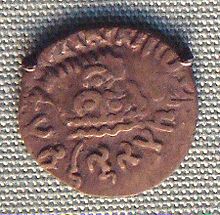- Overstrike (numismatics)
-
A coin of Nahapana overstruck by the Satavahana king Gautamiputra Satakarni. Nahapana's profile and coin legend are still clearly visible.

In Numismatics overstrike refers to the image on a coin which has been coined more than once. Overstriking is done deliberately when the first strike is unsatisfactory, or accidentally if the blank slips out of place or if the dies judder, resulting in a slight doubling of the design.
Sometimes old and worn coins were overstruck with new designs by later rulers. This occurred in the Roman Empire, see sestertius, and also in more modern times. Due to a shortage of silver the mint of George III of Great Britain used Spanish silver dollars in the early 19th century, and overstruck the king's image and legends on them.
Contents
Ancient world
In the ancient world, use of overstrikes was not uncommon, since the manufacture of flans was resource consumptive; thus a foreign or outdated coin could be overstruck with less investment than new mintage.[1] Evidence of overstriking appears as early as about 500 BC when coins of Aegina were overstruck by the ancient city of Kydonia on Crete.[2] In this case and many others, the overstrike can be a valuable aid to dating an ancient coin, an era when dates were not commonly affixed to the design.[3]
See also
Line notes
Reference sources
- Michael Crawford, Emilio Gabba, Fergus Millar and Anthony M. Snodgrass (1983) Sources for Ancient History, Cambridge University Press, 250 pages ISBN 052128958
- C. Michael Hogan, Cydonia, Modern Antiquarian, Jan 23, 2008 [1]
- Otto Mørkholm, Philip Grierson and Ulla Westermark (1991) Early Hellenistic Coinage, Cambridge University Press, 273 pages ISBN 0521395046
Categories:- Numismatics
- Coin stubs
Wikimedia Foundation. 2010.

